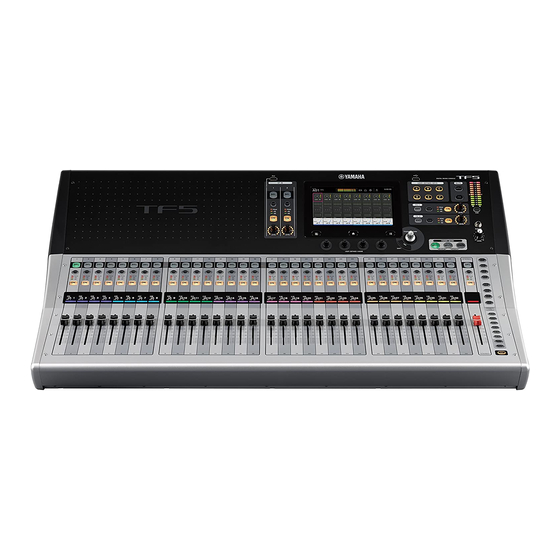
Advertisement
Quick Links
Review from Issue 9/2015
Digital Desk
Yamaha TF Series
Yamaha's Starter Series, comprising three digital desks, features 1-knob and GainFinder thus offering new solutions
ensuring fast and safe handling.
Text and Measuring: Anselm Goertz | Photos: Dieter Stork
Advertisement

Summary of Contents for Yamaha TF Series
- Page 1 Review from Issue 9/2015 Digital Desk Yamaha TF Series Yamaha’s Starter Series, comprising three digital desks, features 1-knob and GainFinder thus offering new solutions ensuring fast and safe handling. Text and Measuring: Anselm Goertz | Photos: Dieter Stork...
- Page 2 CL and QL series, is not included in our basic ver- The MonitorMixApp is suited for smaller displays and allows sion of the TF series. For the first time, though, the TF series access to the monitor mix via the aux busses for up to 10 ex- features an NY expansion slot allowing the bi-directional ternal devices.
- Page 3 Connector panel with analog inputs and outputs, card slot, net- work and USB connector; DANTE can be integrated using a NY64 card Aux mixing for aux bus 1 performed using the Stage Mix app (figure 3) The TF1 has 32, the TF3 and TF5 40 each. The number of The interfaces to acoustic signals, i.e.
- Page 4 TF1, TF3 und TF5 differ in channel count and inputs and faders That’s when audio networks come into play, aiming to pick up as the native network used in the QL and CL series as well as or send audio signals where they are created or needed. This in the corresponding stage boxes.
- Page 5 Sens. 0 dBfs Noise corresp. (lin.) dBfs dBfs –6 –85 –110 –83 –108 –80 –105 –77 –102 –85 –110 Head amp with combined gain setting for analog and digital. The –83 –108 analog adjustment happens in 6 dB intervals, the digital part offers 1 dB steps (figure 4) –8 –80...
- Page 6 – as to be expected – and only start to drop slightly below Yamaha TF1 results in an S/N of 111 dB (linear) and of 113 dB (A) 20 Hz. At a sampling rate of 48 kHz the upper end of the curve noise levels.
- Page 7 Preamp Gain 0 dB THD (red) und THD+N (blue), clipping threshold Gain set to +60 dB THD (red) and THD+N (blue), then clipping is at +25 dBu input level (figure 8) threshold is at –35 dBu input level (figure 9) bit more difficult when the preamp is confronted with higher Distortion levels and their significance gain settings, here + 60 dB.
- Page 8 Test | Yamaha TF Distortion of the TF1 at 0 dB gain and +15 dBu input level Distortion at 60 dB gain and –44 dBu input level (figure 11) (figure 10) already considered to be really good. DIM curves for 0 and Signal processing and structure 60 dB preamp gain are shown in figures 12 and 13.
- Page 9 filter parameters directly as numeric values. Typical for Yamaha: the filters are not compensated with respect to their transfer function. Close to half of the sampling rate, the filter curve will be compressed while sweeping the frequency...
- Page 10 To users who just want to use the desk as soon as possible, proves to be the greatest challenge. You don’t want to set the the TF series offers a lot of features facilitating operation. For levels too low and, maybe, cause noise but, on the other hand, input channels you’ll find ample libraries with preset filter and...
-
Page 11: Dynamic Processing
The gate will react in a reverse way, i.e. reduce the level or shut off the signal path completely when the values fall below the threshold. Controlling compressors YAMAHA TF Both functions imply time constants. The attack time determines how fast a series (figure 19) reaction to exceeding or falling below the threshold will take place. - Page 12 flexibly expanded using a simple and adaptable Dante net- Summary work. The three TF series consoles expand Yamaha’s product range of digital mixing desks in the lower price segment. All 3 models are equipped in a way that enables you to use the consoles’...













Need help?
Do you have a question about the TF Series and is the answer not in the manual?
Questions and answers